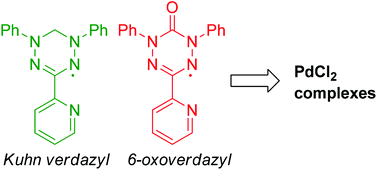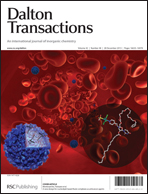The first “Kuhn verdazyl” ligand and comparative studies of its PdCl2 complex with analogous 6-oxoverdazyl ligands†
Abstract
The synthesis and characterization of two new N,N′-diarylverdazyl radical ligands and their corresponding PdCl2 complexes are described. One of the two radicals is of the “Kuhn verdazyl” structure type and was made by adaptation of standard synthetic procedures for this class of verdazyl. The N,N′-diphenyl-6-oxoverdazyl was prepared by hydrolysis of a related tetrazane; the resulting N,N′-diphenylcarbohydrazide was condensed with pyridinecarboxaldehyde and then oxidized to the verdazyl according to standard protocols. Square planar PdCl2 complexes of both verdazyls were prepared by reactions of the radicals with PdCl2 in acetonitrile solution. The structural, spectroscopic, and electrochemical properties of the new verdazyl ligands and their Pd complexes are reported; generally the distinct ligand-centred properties associated with each verdazyl type carry over into the properties of the complexes. The electrochemical studies reveal ligand-centred oxidation and reduction processes; despite the minimal extent of spin delocalization onto Pd in the metal complexes, large shifts in oxidation and reduction potentials (relative to those of the free verdazyl ligands) are discussed.


 Please wait while we load your content...
Please wait while we load your content...